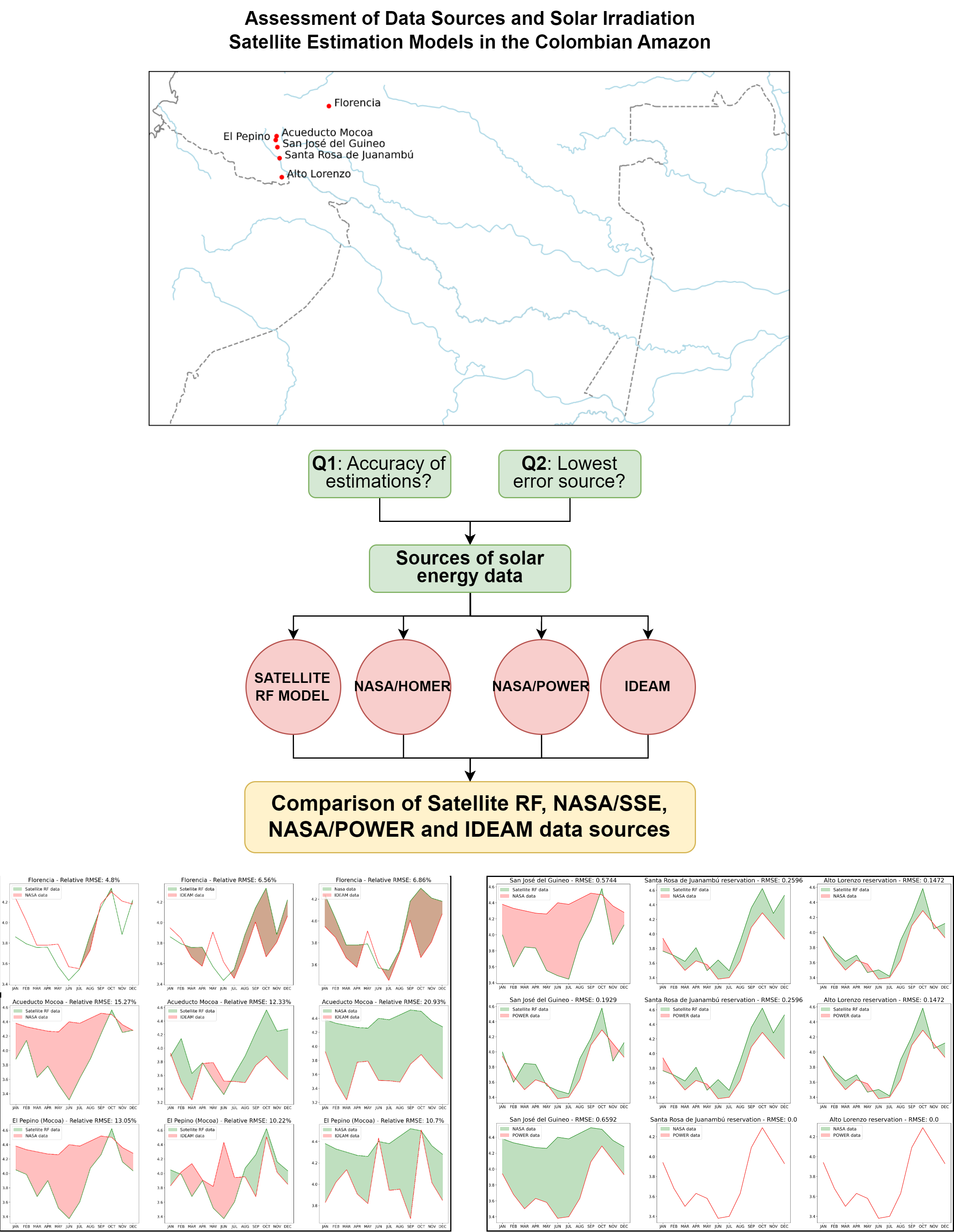Assessment of Solar Irradiation Data Sources and Prediction Models for Rural Villages in the Colombian Amazon Region
Keywords:
Amazon region, Meteorological stations, Photovoltaic Systems, Renewable Energy, Rural villages, Solar RadiationAbstract
Despite global efforts to adopt renewable energy, many remote regions still lack reliable electrical services. Addressing this requires a thorough analysis of solar resource data to identify viable solutions for these underserved areas. We evaluate the error in solar radiation data from a satellite image-based Random Forest (satellite RF) model by using data from IDEAM meteorological stations and NASA sources. By rigorously comparing these datasets, we aim to assess the reliability of predictive sources of solar radiation in the Amazon region. The results help establish confidence in various data sources, essential for utilizing estimated solar energy data in renewable energy research. We compared the data using the Relative Root Mean Squared Error (Relative RMSE). On the one hand, the relative RMSE between NASA and IDEAM ranges from 6.86% to 20.93%. On the other hand, the error between satellite RF model and IDEAM fluctuates between 6.56% and 12.33%. Similarly, the error between satellite RF model and NASA ranges from 4.80% to 15.27%. The findings indicate that the error in NASA data is higher compared to the error in satellite RF model data when benchmarked against IDEAM. Despite the limited number of meteorological stations and a maximum error of 20.93% between the two predictive data sources compared to ground-based observed data, we consider it reliable to use estimated solar radiation data for developing effective renewable energy solutions in remote locations.
Downloads
References
Naciones Unidas, «Apoyar el desarrollo sostenible y la acción climática», United Nations. Accedido: 28 de junio de 2023. [En línea]. Disponible en: https://www.un.org/es/our-work/support-sustainable-development-and-climate-action
Naciones Unidas, «Energías renovables: energías para un futuro más seguro», United Nations. Accedido: 28 de junio de 2023. [En línea]. Disponible en: https://www.un.org/es/climatechange/raising-ambition/renewable-energy
Superservicios, «Informe Sectorial de la Prestación del Servicio de Energía Eléctrica 2021». 2021. [En línea]. Disponible en: https://www.superservicios.gov.co/sites/default/files/inline-files/informe_sectorial_zni_2021%20%281%29.pdf
J. F. Bustos González, A. L. Sepúlveda, y K. T. Aponte, «Zonas no interconectadas eléctricamente en Colombia: problemas y perspectiva». Accedido: 28 de junio de 2023. [En línea]. Disponible en: https://fce.unal.edu.co/centro-editorial/docs/econografos-escuela-economia/65-zonas-no-interconectadas-electricamente-en-colombia-problemas-y-perspectiva
IDEAM, «Consulta y Descarga de Datos Hidrometeorológicos». Accedido: 9 de junio de 2021. [En línea]. Disponible en: http://dhime.ideam.gov.co/atencionciudadano/
V. L. L. Jiménez, «Propuesta Metodológica para el Rediseño de una Red Meteorológica en un Sector de la Región Andina Colombiana», Publicaciones E Investig., vol. 8, pp. 55-76, mar. 2014, doi: 10.22490/25394088.1281.
F. R. Martins, E. B. Pereira, y S. L. Abreu, «Satellite-derived solar resource maps for Brazil under SWERA project», Sol. Energy, vol. 81, n.o 4, pp. 517-528, abr. 2007, doi: 10.1016/j.solener.2006.07.009.
R. A. Escobar et al., «Estimating the potential for solar energy utilization in Chile by satellite-derived data and ground station measurements», Sol. Energy, vol. 121, pp. 139-151, nov. 2015, doi: 10.1016/j.solener.2015.08.034.
I. Sarazola, A. Laguarda, J. C. Ceballos, y R. Alonso-Suárez, «Benchmarking of modeled solar irradiation data in Uruguay at a daily time scale», IEEE Lat. Am. Trans., vol. 21, n.o 9, Art. n.o 9, ago. 2023.
S. Ferrari, F. Zagarella, P. Caputo, y M. Bonomolo, «Assessment of tools for urban energy planning», Energy, vol. 176, pp. 544-551, jun. 2019, doi: 10.1016/j.energy.2019.04.054.
D. Riveros-Rosas, María. E. Sánchez-Diaz, V. M. Velasco-Herrera, A. E. González-Cabrera, M. Valdés-Barrón, y L. F. Zarzalejo, «Implementation of the heliosat 2 model in Mexico from GOES 13 satellités images», AIP Conf. Proc., vol. 2445, n.o 1, p. 150004, may 2022, doi: 10.1063/5.0085648.
L. E. Ordoñez Palacios, V. Bucheli Guerrero, y H. Ordoñez, «Machine Learning for Solar Resource Assessment Using Satellite Images», Energies, vol. 15, n.o 11, Art. n.o 11, ene. 2022, doi: 10.3390/en15113985.
HOMER, «HOMER Pro - Microgrid Software for Designing Optimized Hybrid Microgrids». Accedido: 9 de junio de 2021. [En línea]. Disponible en: https://www.homerenergy.com/products/pro/index.html
NASA, «POWER | Data Access Viewer». Accedido: 21 de marzo de 2023. [En línea]. Disponible en: https://power.larc.nasa.gov/data-access-viewer/
L. E. Ordóñez Palacios, «Evaluación de datos del recurso solar». Accedido: 29 de junio de 2023. [En línea]. Disponible en: https://github.com/luise-phd/evalDatosRecursoSolar
DatosMundial, «Clima: Amazonía en Colombia», DatosMundial.com. Accedido: 21 de junio de 2023. [En línea]. Disponible en: https://www.datosmundial.com/america/colombia/clima-amazonia.php


